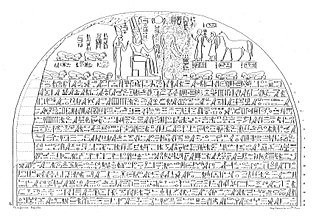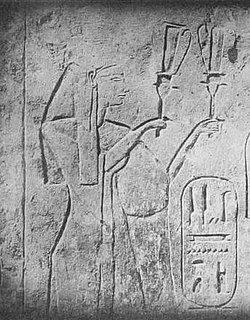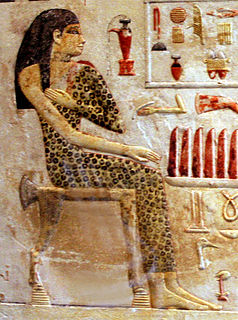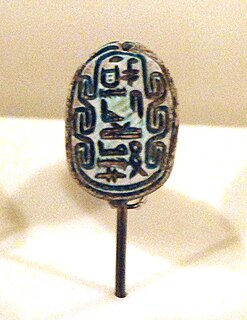Related Research Articles

Nefertari, also known as Nefertari Meritmut, was an Egyptian queen and the first of the Great Royal Wives of Ramesses the Great. Nefertari means 'beautiful companion' and Meritmut means 'Beloved of [the goddess] Mut'. She is one of the best known Egyptian queens, among such women as Cleopatra, Nefertiti, and Hatshepsut. She was highly educated and able to both read and write hieroglyphs, a very rare skill at the time. She used these skills in her diplomatic work, corresponding with other prominent royals of the time. Her lavishly decorated tomb, QV66, is one of the largest and most spectacular in the Valley of the Queens. Ramesses also constructed a temple for her at Abu Simbel next to his colossal monument there.

Piye was an ancient Kushite king and founder of the Twenty-fifth Dynasty of Egypt, who ruled Egypt from 744–714 BC. He ruled from the city of Napata, located deep in Nubia, modern-day Sudan.

Isetnofret was one of the Great Royal Wives of Pharaoh Ramesses II and was the mother of his heir, Merneptah. She was one of the most prominent of the royal wives, along with Nefertari, and was the chief queen after Nefertari's death.

Sobekhotep III was an Egyptian king of the Thirteenth Dynasty of Egypt who reigned three to four years, c. 1740 BC or 1700 BC.

Tiy-merenese, Teye-Merenaset, Tiye-Mereniset(Tiy, Beloved of Isis) was the Great Royal Wife of pharaoh Setnakhte and mother of Ramesses III of the Twentieth Dynasty of Egypt.

Iaret was a Great Royal Wife from the middle of the Eighteenth Dynasty of Ancient Egypt.

Nefertiabet was an ancient Egyptian princess of the 4th Dynasty. She was possibly a daughter of Pharaoh Khufu.

Tabiry was a Nubian queen dated to the Twenty-fifth Dynasty of Egypt.

Mentuemhat or Montuemhat was a Theban official from ancient Egypt who lived during the Twenty-fifth Dynasty of Egypt and Twenty-sixth Dynasty of Egypt. He was the Fourth Priest of Amun in Thebes.

Sobekemsaf(sbk-m-z3=f) was an ancient Egyptian queen of the 17th Dynasty. She was the wife of pharaoh Nubkheperre Intef and sister of an unidentified pharaoh, probably Sekhemre-Heruhirmaat Intef, Sobekemsaf II or Senakhtenre Ahmose.

Sekhemrekhutawy Pantjeny was an Egyptian pharaoh during the Second Intermediate Period. According to the Egyptologists Kim Ryholt and Darrell Baker, he was a king of the Abydos Dynasty, although they leave his position within this dynasty undetermined. Alternatively, Pantjeny could be a king of the late 16th Dynasty. According to Jürgen von Beckerath, Pantjeny is to be identified with Sekhemrekhutawy Khabaw, whom he sees as the third king of the 13th Dynasty.

Senebhenas(snb-ḥnˁ=s, "Health is with her") was the wife and queen consort of the ancient Egyptian king Sobekhotep III, who reigned in the 13th Dynasty, about 1750 BC. The queen is mainly known from a rock stela in the Wadi el-Hol. Here she bears a long title string, including the titles lady of all lands, king's wife and united with the white crown. There she is shown standing behind the king's mother Jewhetibew, indicating that she was the main wife of the king, as a second wife with the name Neni is also known and shown behind here.
Nefer-Setekh is the name of an ancient Egyptian high official, who lived and worked either during the late midst of the 2nd or during the beginning of the 3rd dynasty. He became known by his name, which was addressed to the deity Seth.
Shepset-ipet was an ancient Egyptian princess living during the late 2nd Dynasty. She may have been the daughter of king (pharaoh) Peribsen or Khasekhemwy. She is known by her decorated slab stela.

Sehener was an ancient Egyptian princess living during the late 2nd Dynasty. It is disputed as to who was the king (pharaoh) that reigned during Sehener's lifetime.
Nisuheqet was an ancient Egyptian king's son of the Second Dynasty. Nisuheqet is only known from his stela found in tomb 964.H.8 at Helwan. The only title he bears on this monument is king's son. The stela is made of limestone and shows the prince on the left, sitting on a chair with an offering table and offerings in front of him. The stela was discovered in excavations by Zaki Saad at Helwan, that were conducted between 1952 and 1954. The royal father of this king's son remains unknown.
Satkhnum was an ancient Egyptian king's daughter who lived most likely in the Second Dynasty. She is only known from her stela once placed in her tomb and found at Helwan. On the stela Satkhnum is shown sitting on a chair in front of an offering table. Next to the offering table are shown many offerings. Above this scene is a short text: Satkhnum, the king's daughter. Her royal father is not known. On stylistical grounds the stela is datable to the Second Dynasty.

At Helwan south of modern Cairo was excavated a large ancient Egyptian cemetery with more than 10.000 burials. The cemetery was in use from the Naqada Period around 3200 BC to the Fourth Dynasty and again at the beginning of the Middle Kingdom and then up to the Roman Period and beyond. The burial ground was discovered and excavated by Zaki Saad in 1942 to 1954. Further excavations started in 1997 by an Australian expedition. The excavations of Zaki Saad were never fully published, only several preliminary reports appeared. Helwan was most likely the cemetery of Memphis in the first Dynasties. The tombs range from small pits to bigger elaborated mastabas. Regarding the underground parts of these tombs, two types are attested. There are on one side pits with the burial at the bottom and there are on the other side underground chambers, reached via a pit or via a staircase. The majority of burials are for one deceased.
Meriiti was an ancient Egyptian official living at the end of the First Dynasty around 2900 BC. He is only known from his stela found in tomb 810.H.11 at Helwan. The stela was found in the burial chamber next to the coffin. It shows on the left Meriiti sitting on a chair with offerings in front of him. On the right side of the stela is a list of Meriiti's titles.

Nofret was an ancient Egyptian king's wife who is so far only known from one stela that is today in the Egyptian Museum in Cairo. The stela was found at Abydos. The stela dates most likely to the 13th Dynasty and belongs to the ruler of the king's crew Nedjesankh/Iu. His wife was the king's daughter Hatshepsut. The text stats that the latter was born to the king's wife Nofret. Not much can be said about her. Her royal husband is not yet identified.
References
- ↑ E. Christiana Köhler, Jana Jones: Helwan II, The Early Dynastic and Old Kingdom Funerary Relief Slabs, Studien zur Archäologie und Geschichte Altägyptens, Band 25, Rahden 2009, ISBN 978-3-86757-971-1, p. 168-169
